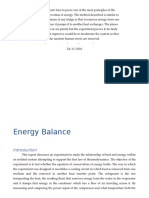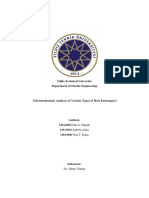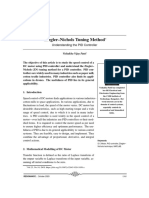Dryness Fraction of Steam Lab
Dryness Fraction of Steam Lab
Uploaded by
Roneil NapierCopyright:
Available Formats
Dryness Fraction of Steam Lab
Dryness Fraction of Steam Lab
Uploaded by
Roneil NapierCopyright
Available Formats
Share this document
Did you find this document useful?
Is this content inappropriate?
Copyright:
Available Formats
Dryness Fraction of Steam Lab
Dryness Fraction of Steam Lab
Uploaded by
Roneil NapierCopyright:
Available Formats
University of Technology, Jamaica
MECHANICAL TECHNOLOGY
Dryness Fraction of Steam
Name: ID: Group: Date:
Roneil Napier 9712441 B.ENG 4E (Art.) July 21st, 2011
LAB 2 - DRYNESS FRACTION OF STEAM
Objective To gain familiarity with the main components and operation of a gas fired steam boiler. To determine the dryness fraction of steam sampled from the pipeline
Theory A separating calorimeter uses mechanical means to separate the liquid from the vapour in a wet steam sample. The separated vapour is then passed through a water-cooled condenser, so that it can be collected as a liquid. Let mf = mass collected from separator mg = mass collected from condenser. Then, apparent dryness fraction of steam sample,
xa
However, the separation process is imperfect, and some amount of liquid is included with mg. If a throttling calorimeter is placed after the separator, the fall in pressure during the throttling process carries the separated vapour over into the superheat region. This then allows the enthalpy of the superheated vapour, h2, to be determined from steam tables, if the pressure and temperature after throttling is measured.
LAB 2 - DRYNESS FRACTION OF STEAM
Assuming constant enthalpy for throttling process, h2 = h1 = hf1 + xhfg1.
Hence, dryness fraction of vapour entering throttling calorimeter,
xb
Therefore, actual mass of separated vapour = xb (mg).
Actual dryness fraction of steam sample
= xb*xa.
LAB 2 - DRYNESS FRACTION OF STEAM
Apparatus
Boiler Manufacturer Model Serial Working Pressure Fuel Equivalent Evaporation
Tubeless Steam Boiler (Vertical) HURST 0850823 V86-200-4 150 psig (~10.3 bar) Diesel 1035lbs (~469.5kg) from and @ 212oF (100oC)
Combined separating and throttling calorimeter (Norwood Instruments, England). Thermometer Large and small cylindrical collection vessels Triple beam balance Fortin barometer
Figure 1 Apparatus
LAB 2 - DRYNESS FRACTION OF STEAM
Procedure The arrangement of the boiler was observed and sketched to show the main accessories and control components. The water level in the boiler was checked to ascertain whether it was in the operating range on the sight glass. The air vent at the top of the boiler was then opened to ensure the expulsion of air from the boiler. The Treatment Chemical dosing line and the feed water line valve to the boiler were then opened. The lock-off valve on the Diesel Fuel supply line was then opened and the boiler fired. The startup sequence was then observed. When steam began to emit from the air vent valve, the valve was closed slowly in order to prevent the water level from rising in the sight glass. The boiler was then allowed to pressurize. The masses of the small and large containers were determined by weighing them. When the boiler had run-up to pressure, valves A and E (located at the top of the steam lagging apparatus) were opened just wide enough to allow a slow bleed of steam through the pipeline. This heated the pipeline and evaporated any condensate that was present. After ensuring that valve D was closed, valve C was opened very slowly. Valve F (on the upper lagged leg on the Lagging Apparatus) was cracked open to the marked position so as to permit a slight bleed of steam. This was done in order to minimize condensation on the steam line. Valve C was then closed after adequate heat was supplied to the apparatus, and the throttled Steam Thermometer T2 showed a reading that was above 90oC. A container was positioned below the condenser to collect the condensate. With the use of gloves, valve D was gradually opened to release liquid from the mechanical separator. Valve D was then reclosed and cooling water turned on to flow moderately into the condenser. The large container was then placed below the condenser to collect the condensate. Valve C was then slowly reopened fully to allow
5
LAB 2 - DRYNESS FRACTION OF STEAM
the steam to flow through the apparatus. After it was observed that the steam was superheated, readings of steam line pressure, water manometer, and thermometer readings were taken. When an adequate volume of water was collected in the large container, valve C was closed. After sufficient time had passed to allow all condensate to drain from the condenser, the small container was again placed at the outlet of valve D which was then gradually opened to collect all the water from the mechanical separator, after which valve D was reclosed. The containers were then weighed with their contents. In taken the atmospheric pressure, the cistern adjusting screw at the base of the fortin barometer was rotated until the surface of the mercury in the cistern just touched the tip of the tapered zero pointer. The vernier scale was then positioned such that the lower edge of the scale was level with the top of the mercury meniscus with two triangular spaces visible on each side of the mercury column, after which its height was recorded. The temperature in the barometer cabinet, the barometer reading, and the corresponding correction multiplier were then recorded.
Figure 2
Sketch of Vertical Tubeless Boiler
Boiler Firing Sequence The control firing sequence occurs at cold startup or when the steam pressure drops. The pressure control completes an electric circuit, which starts a timer motor cam turning in the programmer. The first contact on the timer motor cam closes and starts the burner motor that rotates the primary air fan. The primary air fan blows air into the furnace to purge any unburned fuel present in a gaseous condition. This process in called pre-purging the furnace. By prepurging the furnace before pilot ignition, the danger of a furnace explosion is reduced. Depending upon the size of the furnace the purge cycle takes approximately 30 seconds but may take as long as 60 seconds. The programmer is still operating and when the second contact closes, the circuit of the ignition transformer is completed. This causes a spark in front of the gas pilot tube. At the same time, a solenoid valve is opened in the gas pilot line, allowing gas to flow through the gas pilot tube and be ignited by the spark. The scanner is located on the front of the boiler and is used to sight the pilot. Sighting the pilot through the scanner will verify that the pilot is lit. This process is referred to as proving pilot. The next step is to close the contact which completes the circuit to the main fuel valve, which opens only after the scanner has proved pilot. With the main fuel valve open the fuel enters the furnace and is ignited by the pilot. The scanner is then used to prove the main flame. The programmer continues to operate for a few more seconds, securing circuits to the ignition transformer and the gas pilot. After the circuits are secured, the programmer stops. The burner is now regulated by the pressure control and the modulating pressure control. If the scanner senses
LAB 2 - DRYNESS FRACTION OF STEAM
a flame failure, the system is purged and secured. The programmer is then manually reset to the start cycle.
LAB 2 - DRYNESS FRACTION OF STEAM
Results
Parameters Mass (Small Container) Empty With Contents Empty With Contents
Group 1 Readings Value 1.65 2.10 0.45 1.60 10.0 8.4 117 68 1.5 102 746 32 0.00519 Inst. Units lb lb lb lb lb lb MN/m2 (psig)
o
Group 2 Readings Value 0.748 0.953 0.205 0.726 4.536 3.810 8.0672 341 0.1034 375 0.746 305 0.00519 SI Units kg kg kg kg kg kg bar K bar K m of Hg K Null
Mass of Separated Liquid, Mw Mass (Large Container)
Mass of Condensed Vapour, Ms Line Steam Pressure, P1 Line Steam Temperature, T1 Throttled Steam Pressure, P2 Throttled Steam Temperature, T2 Mercury Column Height Fortin Barometer Temperature Height Container Factor Gravity = 9.784 ms-2
C C C
Inch (w.g.)
o
mm of Hg
o
Null
Figure 3
10
LAB 2 - DRYNESS FRACTION OF STEAM
Separating and Throttling Calorimeter
11
LAB 2 - DRYNESS FRACTION OF STEAM
Sample Calculations
Conversions:
K 68 oC
= oC + 273 = (68 + 273) K = 341 K
1 psi 117 psi i.e. P1
= 6.895 kPa = (117 * 6.895) kPa = 806.72 kPa
Calculation of Apparent Dryness Fraction of Steam Sample xa: xa =
= 0.949
Absolute pressure, Pabs = Gauge pressure, Pgauge + Atmospheric pressure, Patm
12
LAB 2 - DRYNESS FRACTION OF STEAM
Patm
= Hggh
Now h = Mercury Column Height (Mercury Column Height Height Container Factor) = 0.746 (0.746 * 0.00519) = 0.742 mHg
Patm
= 13595.5 * 9.784 * 0.742 = 98,699.63 Pa = 0.987 bar ~ 1.0 bar
Working pressure, P = P1 + Patm = 8.067 + 1 = 9.067 bar
Pressure of Throttled Steam, P2 = Manometer pressure, Pm + Atmospheric pressure, Patm h = 1.5 in = 0.0381 m
Pm
= 1000 * 9.784 * 0.0381 = 373.77 Pa = 0.00373 bar
P2
= 0.00373 + 1.0
13
LAB 2 - DRYNESS FRACTION OF STEAM
= 1.00373 bar
Calculation of Dryness Fraction of Vapour Entering Throttling Calorimeter, xb
For hf at 9.067 bar: From Steam Tables and by Interpolation:
P (bar) 10.0
=
9.067
hf
= (0.067 * 20) + 743 = 744.34 kJ/kg
9.0 743 hf 763 h (kJ/kg)
For hfg at 9.067 bar: From Steam Tables and by Interpolation:
P (bar) 10.0
=
9.067
hfg = (0.067 * -16) + 2031 = 2029.93 kJ/kg
9.0 2031 hfg 2015 hfg (kJ/kg)
14
LAB 2 - DRYNESS FRACTION OF STEAM
The temperature of the throttled steam is 102 oC which tells us that it is superheated. From the superheated section of the steam tables and by interpolation: At 1 bar:
=
h2 = (0.4 * 101) + 2676 = 2716.4 kJ/kg
102
T (oC) 150
xb
=
100
=
2676 h2 2777
h (kJ/kg)
= 0.922
Actual dryness fraction of steam sample, x: x = xa * xb = 0.949 * 0.922 = 0.875
15
LAB 2 - DRYNESS FRACTION OF STEAM
Discussion The dryness fraction of steam describes how dry steam is, with a value of 1 representing steam that is 100% dry, and therefore free of entrained moisture. Steam with a dryness fraction of 0.99 consists of 99% steam and 1% water. If we measure the latent heat present in steam that has a dryness fraction of 0.99 we will find that it possesses 99% of the full quotient of latent heat. The actual dryness fraction in this experiment was calculated to be 0.875, and was found to be lower than both xa and xb which are 0.949 and 0.922 respectively. From the analogy in the paragraph above, we can deduce that the steam under investigation consisted of 87.5% steam and 12.5% water, intrinsically a 7:1 ratio. While this fraction may be acceptable for some processes, others may require a drier degree of steam or even steam that is less dry. The amount of water (12.5%) present in the sample of steam under observation can be attributed to errors that may have occurred during the experiment, leading to the incomplete separation of water. Possible sources are human errors in the form of parallax or reading accuracy when measurements were taken, and calculations. There was also evidence of steam escaping into the room resulting in systematic errors which might have altered room temperature and pressure. Conclusion The objectives of this laboratory exercise were realized, thus validating this experiment.
16
LAB 2 - DRYNESS FRACTION OF STEAM
References Van Ness, H. C. (1983). Understanding Thermodynamics. Dover Publications; Dover ed edition (January 1, 1983). ISBN-13: 978-0486632773
17
You might also like
- Separating and Throttling CalorimeterDocument11 pagesSeparating and Throttling CalorimeterSims Gift Shiba75% (4)
- Gunpla Judging Version 1Document43 pagesGunpla Judging Version 1api-669648727100% (1)
- Manometers DiscussionDocument3 pagesManometers DiscussionIshan Madhusanka82% (33)
- U4526113 Rankine Cycle Lab ReportDocument7 pagesU4526113 Rankine Cycle Lab ReportTegan Doblinger100% (2)
- Bernouli Lab ReportDocument18 pagesBernouli Lab ReportUgeswran Thamalinggam100% (3)
- Centrifugal Pump Final Lab ReportDocument14 pagesCentrifugal Pump Final Lab Reportcracking khalifNo ratings yet
- Thermal ConductivityDocument17 pagesThermal Conductivityقاسمي عندام50% (2)
- Energy BalanceDocument16 pagesEnergy BalancewizlanNo ratings yet
- Duhok Polytechnic University Technical College of Engineering Petrochemical Department Transport Phenomena Fourth Year-2018-2019Document10 pagesDuhok Polytechnic University Technical College of Engineering Petrochemical Department Transport Phenomena Fourth Year-2018-2019Bryar XalilNo ratings yet
- Experiment 1Document9 pagesExperiment 1Shaun Loo50% (2)
- Dryness Fraction of Steam ExpDocument5 pagesDryness Fraction of Steam ExpAthinaNo ratings yet
- Marcet BoilerDocument18 pagesMarcet BoilerCendolz IssZulNo ratings yet
- Bernoulli's Theorem DemonstrationDocument17 pagesBernoulli's Theorem DemonstrationjjNo ratings yet
- Energy Losses in Bends and FittingsDocument11 pagesEnergy Losses in Bends and FittingsQuenneBelocura100% (1)
- Marcet Boiler Lab ReportDocument8 pagesMarcet Boiler Lab ReportInilazi JimmyNo ratings yet
- Bernoulli's PrincipleDocument8 pagesBernoulli's PrincipleMD Atiqur Rahman Faisal100% (1)
- Cooling Tower LabDocument33 pagesCooling Tower Labkeckstand100% (2)
- Experiment 5Document5 pagesExperiment 5FizaFiy100% (3)
- Lab Report 2Document16 pagesLab Report 2Limmy Yingran0% (1)
- Lab Report Marcet Boiler ThermofluidsDocument21 pagesLab Report Marcet Boiler ThermofluidsSolehin Shukur100% (1)
- Experiment 5 - Calibration of Bourdon Tube Pressure GaugeDocument6 pagesExperiment 5 - Calibration of Bourdon Tube Pressure GaugeKhairil Ikram100% (1)
- Fdocuments - in 51634963 Orifice Discharge Lab ReportDocument2 pagesFdocuments - in 51634963 Orifice Discharge Lab ReportKaty PerryNo ratings yet
- Experiment #3 Venturi Meter: Home Unquantized ProjectsDocument7 pagesExperiment #3 Venturi Meter: Home Unquantized ProjectsEddy KimathiNo ratings yet
- 2 Stage Air Compressor 2h PDocument9 pages2 Stage Air Compressor 2h PNilesh Vijay SabnisNo ratings yet
- Change of State of Gases ExperimentDocument6 pagesChange of State of Gases ExperimentRetriana Maharani Retri100% (1)
- Lab Report Marcet BoilerDocument8 pagesLab Report Marcet BoilerAnis Thuraiya100% (1)
- HP Lab Report TrifilarDocument11 pagesHP Lab Report TrifilarHorciuxes IraniNo ratings yet
- Lab2 Sem 3 Fluid Mixing 2019Document18 pagesLab2 Sem 3 Fluid Mixing 2019mohdyashfi mppNo ratings yet
- Pipe FrictionDocument4 pagesPipe FrictionShubham ChauhanNo ratings yet
- Flow Measurement Lab5Document18 pagesFlow Measurement Lab5Jérôme J. JeitanyNo ratings yet
- Lab 4 Thermal ConductivityDocument8 pagesLab 4 Thermal ConductivityShung Tak Chan100% (1)
- Properties Measurement PVT Lab Report UitmDocument35 pagesProperties Measurement PVT Lab Report UitmAmrun Rusrl100% (1)
- Bernoilli's Principle Lab ReoprtDocument2 pagesBernoilli's Principle Lab ReoprtJohnConor100% (2)
- Orifice and Free Jet Flow: University of NebraskaDocument8 pagesOrifice and Free Jet Flow: University of NebraskaJemuel Flores100% (1)
- Reynolds ExperimentDocument4 pagesReynolds ExperimentShubhangi Bansude100% (1)
- MCE 4423 Experiment 4 - Efficiency and Performance of A Pelton TurbineDocument16 pagesMCE 4423 Experiment 4 - Efficiency and Performance of A Pelton TurbineMan AlbNo ratings yet
- Fluid Lab 2 - Bernoulli ExpDocument19 pagesFluid Lab 2 - Bernoulli ExpCik Tiem Ngagiman89% (65)
- CDB 3062 Chemical Engineering Lab 3 MAY 2016: Group: 03 Date Experiment Group MembersDocument14 pagesCDB 3062 Chemical Engineering Lab 3 MAY 2016: Group: 03 Date Experiment Group MembersZen AlkaffNo ratings yet
- Experiment 7 (Refrigeration Unit)Document16 pagesExperiment 7 (Refrigeration Unit)fadhilahmad50% (2)
- Experiment On Performance of Centrifugal PumpDocument7 pagesExperiment On Performance of Centrifugal PumpSyfNo ratings yet
- Boiler Lab ReportDocument6 pagesBoiler Lab ReportYomal Wijesinghe0% (2)
- Venturimeter LAB ReportDocument7 pagesVenturimeter LAB ReportJames Roy100% (1)
- Heat Exchanger Lab ReportDocument15 pagesHeat Exchanger Lab ReportOmar Samir100% (1)
- Refrigerator ReportDocument21 pagesRefrigerator Reportwandee2393100% (1)
- CLB20703 Chemical Engineering Thermodynamics Experiment 1: Refrigeration CycleDocument7 pagesCLB20703 Chemical Engineering Thermodynamics Experiment 1: Refrigeration CycleSiti Hajar MohamedNo ratings yet
- Fluid Flow Measurement Lab: ObjectDocument9 pagesFluid Flow Measurement Lab: ObjectAboodNo ratings yet
- Marcet Boiler ExperimentDocument4 pagesMarcet Boiler ExperimentMohammed Islam100% (1)
- Full Report Bernoulli Experiment TiqaDocument19 pagesFull Report Bernoulli Experiment TiqaAtiqah Samad100% (5)
- Lab 2-Water Cooling TowerDocument31 pagesLab 2-Water Cooling Towerriniz92100% (4)
- Experiment 2 - Forced Draft Cooling TowerDocument14 pagesExperiment 2 - Forced Draft Cooling TowerSonia YuNo ratings yet
- Bernoulli Theorem DemonstrationDocument27 pagesBernoulli Theorem DemonstrationmanzahuhuNo ratings yet
- Corrosion Lab ReportDocument10 pagesCorrosion Lab ReportSAFINA KAMAL SHOILYNo ratings yet
- Lab Report - Energy Losses in Pipe: 1 SummaryDocument10 pagesLab Report - Energy Losses in Pipe: 1 SummaryYoung HowNo ratings yet
- Serial and Parallel Pump Operations-Variable Speed Pump DriveDocument10 pagesSerial and Parallel Pump Operations-Variable Speed Pump DriveAyberk ArdıçNo ratings yet
- Boiler:: Working Principle of A BoilerDocument22 pagesBoiler:: Working Principle of A BoilerZeshan AbdullahNo ratings yet
- Exp.2-Principles of Saturation Pressure MeasurementDocument65 pagesExp.2-Principles of Saturation Pressure MeasurementAmir Hamzah25% (4)
- Ppe Exp.3 ROLLNO 1Document9 pagesPpe Exp.3 ROLLNO 1Aniket SinghNo ratings yet
- ME-495 Laboratory Exercise Number 3 ME Dept, SDSU - KassegneDocument6 pagesME-495 Laboratory Exercise Number 3 ME Dept, SDSU - KassegneJasmine_lai00No ratings yet
- Laboratory Report 3Document6 pagesLaboratory Report 3Kim TanNo ratings yet
- Strategies To Improve After Clearing CA Intermediate ResultDocument4 pagesStrategies To Improve After Clearing CA Intermediate ResultCA Entrance Exam BooksNo ratings yet
- Hbef2203-Information Technology in EducationDocument14 pagesHbef2203-Information Technology in EducationSimon RajNo ratings yet
- Assignement 3 (Case Study 2)Document1 pageAssignement 3 (Case Study 2)Nisan ThapaNo ratings yet
- I RD BalancingDocument6 pagesI RD BalancingChoochart ThongnarkNo ratings yet
- Tai Wai, Hong KongDocument2 pagesTai Wai, Hong KongcanonscanmenaNo ratings yet
- CPQMDocument2 pagesCPQMOlayinkaAweNo ratings yet
- CV Ir. Hilman Hakim MBA As Per June 2022Document14 pagesCV Ir. Hilman Hakim MBA As Per June 2022hakim_hilmanNo ratings yet
- 1.3 Prelim Exam Answer Sheet Ewk2Document3 pages1.3 Prelim Exam Answer Sheet Ewk2Margaux EstrellanNo ratings yet
- PreviewpdfDocument132 pagesPreviewpdfGlycel ValdezNo ratings yet
- Best Mobile Under 40000 in PakistanDocument42 pagesBest Mobile Under 40000 in PakistanMohammad AtherNo ratings yet
- Module2 - Topic5 - Week7 - Differential EquationDocument5 pagesModule2 - Topic5 - Week7 - Differential EquationCHEZANIE MIYA ASUNCIONNo ratings yet
- The Origin and Development of Management Accounting: M Shotter School of Accountancy University of PretoriaDocument27 pagesThe Origin and Development of Management Accounting: M Shotter School of Accountancy University of PretoriaJulius MwambiNo ratings yet
- The Tea Handbook FinalDocument103 pagesThe Tea Handbook FinalRakshana100% (1)
- EE611 Problem Set 3: (0,1+sqrt (3) )Document2 pagesEE611 Problem Set 3: (0,1+sqrt (3) )anon020202No ratings yet
- Journal of Environmental Management: Juvancir Da Silva, Valdir Fernandes, Marcelo Limont, William Bonino RauenDocument10 pagesJournal of Environmental Management: Juvancir Da Silva, Valdir Fernandes, Marcelo Limont, William Bonino RauenDaniela Ramirez EnriquezNo ratings yet
- Benefits of Xero As Your Business Accounting SystemDocument1 pageBenefits of Xero As Your Business Accounting SystemGeeAgayamPastorNo ratings yet
- PSY 201 Test #2Document9 pagesPSY 201 Test #2nas4243No ratings yet
- 2015/2016 Semester Tuition Fees For Year One International StudentsDocument2 pages2015/2016 Semester Tuition Fees For Year One International StudentsAnonymous 0wXXmp1No ratings yet
- AAPS Poster 2012 PDFDocument1 pageAAPS Poster 2012 PDFaryopoorNo ratings yet
- Helen Joy Leal (Book 1,2,3)Document21 pagesHelen Joy Leal (Book 1,2,3)gianroqueabejuela443No ratings yet
- Humanistic Psychology and Metapsychology: Amedeo GiorgiDocument29 pagesHumanistic Psychology and Metapsychology: Amedeo GiorgimacNo ratings yet
- JURNAL SKRIPSI 2020 PDFnya PDFDocument10 pagesJURNAL SKRIPSI 2020 PDFnya PDFmuh.rizky nur rizkyNo ratings yet
- Convertidor Mechanical S108KDocument8 pagesConvertidor Mechanical S108KALBERTONo ratings yet
- 2qth-Order Cumulants Based Virtual Array of A Single Acoustic Vector SensorDocument14 pages2qth-Order Cumulants Based Virtual Array of A Single Acoustic Vector SensorumeshNo ratings yet
- Ziegler-Nichols Tuning Method: Understanding The PID ControllerDocument13 pagesZiegler-Nichols Tuning Method: Understanding The PID ControllerSaran SelvanNo ratings yet
- Applied Ocean Research: Yuanyuan Wang, Shuhong Chai, Faisal Khan, Hung Duc NguyenDocument13 pagesApplied Ocean Research: Yuanyuan Wang, Shuhong Chai, Faisal Khan, Hung Duc NguyenMilton AlvaradoNo ratings yet
- Propagation of Radio Waves in The AtmosphereDocument14 pagesPropagation of Radio Waves in The AtmosphereJuampi MochenNo ratings yet
- MSCHW!C010Document1 pageMSCHW!C010mjdeNo ratings yet
- 4 HydraulicsDocument63 pages4 HydraulicsDiego BernalNo ratings yet

























































































